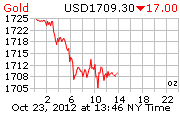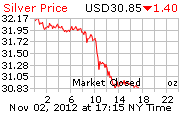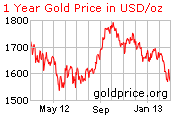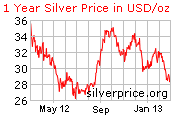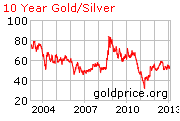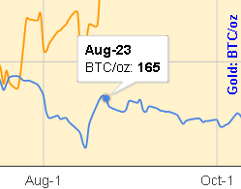How Gold and Silver Prices Were Suppressed Early This Week
By Patrick A. Heller
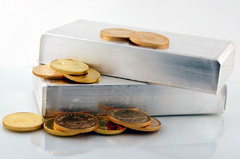 There were certainly a number of reasons for the US government and its trading partners and allies to want to knock down gold and silver prices early this week. Though there are any number of factors that influence prices, here are just some of the reasons why precious metals prices needed to get clobbered.
There were certainly a number of reasons for the US government and its trading partners and allies to want to knock down gold and silver prices early this week. Though there are any number of factors that influence prices, here are just some of the reasons why precious metals prices needed to get clobbered.
- Gold reached another all-time high (ignoring inflation) of $1,474.40 and silver broke above the psychological $40.00 threshold last Friday for the first time in more than 31 years. Momentum was building for even higher prices.
- The US 10-year Treasury debt interest rate rose above 3.5% last Thursday and Friday, as a signal of possible further near term increases in interest rates.
- The US Dollar Index last Friday fell to 75.06, its lowest level since late 2009.
- The US government would want to look good in advance and during President Obama’s speech on Wednesday on the subject of reducing the budget deficit.
- The US government also wants to look good going into the upcoming G-20 meetingon Friday and the International Monetary Fund and World Bank meetings coming up Friday through Sunday this weekend.
- The monthly options expirations were coming up for the GLD and SLV gold and silver exchange traded funds on April 16. Higher gold and silver prices would result in larger demand for the delivery of physical metals, which would exert pressure for even higher prices.
- Oh yeah, politicians in Washington DC pushed the Federal government to the brink of a partial shutdown last Friday night, clearly demonstrating the incompetence of Congress and the Administration in the performance of their respective duties.
If you have watched the market, you saw the price of gold decline a bit over 2% and silver drop over 5% from its highs reached in Asian and European markets early Monday. The mainstream media, as usual, got it wrong when it reported that the decline was due to “profit taking.” Here’s some of what really happened.
- The US government’s trading partners apparently signal an upcoming suppression of gold and silver prices by first knocking down the HUI Index, an indicator of gold mining company stock prices. The sudden drop in the HUI Index early Monday was followed within hours by the drop in gold and silver prices. The HUI Index continued falling on Tuesday.
- At the same time that the HUI started falling on Monday, Goldman Sachs came out with a recommendation that people sell their gold, silver, and a few other commodities such as oil to take advantage of what they believed to be temporary market tops. Goldman Sachs is the lead trading partner for the US Treasury (JPMorgan Chase is the lead trading partner for the Federal Reserve) so any such announcement that they might make could be to follow the orders of the US government to manipulate such markets.
- If there was profit taking on the COMEX early this week, the number of open contracts would decline as owners of long contracts closed out their positions. On Monday, the number of open contracts in both the COMEX gold and silver marketsincreased, indicating the creation of new contracts by short sellers.
- On Monday, the largest options transaction in the US was a put for 100,000 contracts of 100 shares each of SLV at a strike price of $25 per share before expiration in July 2011. The position will cost the buyer $1 million if the price of silver does not drop before July. When this trade was reported by Bloomberg, the price of silver had fallen enough by then that the owner of these options could have doubled his money. However, silver’s price has recovered significantly since then, possibly eliminating his entire profit position. Such a trade does not make sense to me unless it was solely an attempt to force down the price of silver. If the price of silver continues to recover and even moves higher through the July expiration date, the options would expire worthless.
- Shares of SLV, which had recently been trading at about 40 cents per ounce below the silver spot price, fell to $1.00 below the spot price.
- At the same time, the US 10-year Treasury debt interest rate was wrestled downward, closing in US markets at 3.5% on Tuesday.
- Both Federal Reserve Vice Chair Janet Yellen and Federal Reserve Bank of New York President William C. Dudley gave speeches on Monday in which they supported the latest report by the US Bureau of Labor Statistics that consumer prices had increased barely 2% in the past year. Both asserted that increases in food and energy costs should be ignored in determining the increase in consumer prices. These speeches contradicted recent speeches by regional Federal Reserve Bank presidents James Bullard (St Louis) and Richard Fisher (Dallas) last week.
Even though, in my judgment, gold and silver prices continue to be in a long-term bull market, prices will not rise in a straight line. What we have seen in the past few years is that the periodic price drops, whether as a result of free market actions by investors or outright price suppression at the direction of the US government, are of a lesser percentage than before and are of shorter duration. In effect, the temporary drop in prices this week will likely prove to be another bargain buying opportunity.
Meanwhile, there is another factor affecting the trading of physical gold and silver this week. It has been a consistent pattern for several years that there is a decline in demand in US markets around the deadline for filing personal income tax returns. Typically, demand slows down about a week before April 15 (April 18 this year) and does not pick back up until a couple days after that deadline. Although my companies have seen significant demand for silver (mostly) and gold (to a lesser degree), it definitely looks like this pattern is happening again this year. In our judgment, we would have sold much more gold and silver this week were it not for the occurrence of the annual tax deadline.
There are many more reasons why the US government might want to suppress gold and silver prices. There is also a huge arsenal of tactics that could be employed for that purpose. At the most extreme, we could see a repeat of a rules change that the COMEX adopted in January 1980 at the gold and silver market peaks. At one point back then the COMEX prohibited anyone from purchasing a new long silver contract and would only permit parties who owned long contracts to liquidate them back to the parties who held short positions.
This rule change back in 1980 was done specifically to punish two private silver investors, the Hunt Brothers. There are no “villains” as such this time around as the demand for silver (and gold) is extremely widespread and includes several governments and central banks. Should the US government push for an identical rule change today, it would be punished by other nations who would sell off their dollars and US Treasury debt. So, while I don’t anticipate such an extreme rule change in the foreseeable future, other lesser rule changes are quite possible.
Just keep in mind that the more extreme the efforts by the US government and its trading partners and allies to hold down gold and silver prices, the higher the prices will eventually climb. Don’t be fooled into selling your physical gold and silver because you think that prices will be held down forever.




